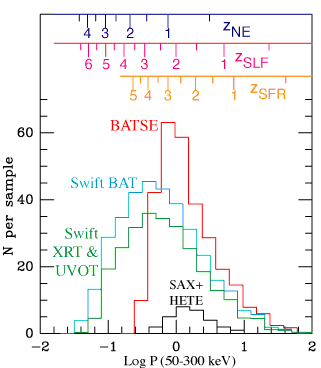What Can Gamma Rays Tell us About the Early Universe?
Since GRBs are the most luminous objects in the Universe, they provide a unique opportunity to probe the intergalactic medium (IGM) and the ISM of the host galaxies via measurement of absorption along the line of sight. Depending on evolution, GRBs might originate from redshifts up to ~20 and have a median redshift > 2. The most distant GRB to date is at a redshift of 4.5.
| GRB Intensities & Redshifts |
|---|

|
| Swift bursts vs peak flux: All BAT detections (blue) and complete XRT and UVOT redshift observations (green) compared to normalized BATSE and BeppoSAX/HETE-II distributions. Top scales show corresponding redshift for the three models in the Log N - Log P plot. UVOT and XRT redshift measurements of faint bursts measured by BAT will distinguish between models. |
Swift, by obtaining a large sample of GRBs over a wide range of fluences and redshifts, will determine whether their evolution follows that of star formation in the Universe and,
because the X-ray flux does not depend greatly on the line of sight column, these results will be independent of absorption.
By obtaining a large number of redshifts, Swift will directly measure the luminosity function of GRBs and their evolution with cosmic time. Such analysis typically requires a large
sample (hundreds). This will be only the third population (after quasars and galaxies) for which such a direct measurement is possible. If GRBs map the regions where massive stars
are formed, then this measurement will be of fundamental cosmological importance, measuring the star formation rate deeper than currently possible.
By rapidly providing both accurate positions and an optical magnitude, Swift will enable the rapid follow-up of those GRBs bright enough for high resolution optical absorption line
spectroscopy at redshifts large enough to study the re-ionization of the IGM. This information on the high-z Ly-α forest will be unique because there are no known bright (m <
17) galaxies or quasars at z > 4.8.

|
| Swift notifies observers of high-redshift GRBs with bright afterglows, which provide the best back lights to illuminate Z > 4 Ly-α forest. |
If you have a question about Swift, please contact us via the Feedback form.


